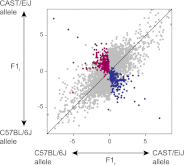Extensive compensatory cis-trans regulation in the evolution of mouse gene expression
- PMID: 22919075
- PMCID: PMC3514667
- DOI: 10.1101/gr.142281.112
Extensive compensatory cis-trans regulation in the evolution of mouse gene expression
Abstract
Gene expression levels are thought to diverge primarily via regulatory mutations in trans within species, and in cis between species. To test this hypothesis in mammals we used RNA-sequencing to measure gene expression divergence between C57BL/6J and CAST/EiJ mouse strains and allele-specific expression in their F1 progeny. We identified 535 genes with parent-of-origin specific expression patterns, although few of these showed full allelic silencing. This suggests that the number of imprinted genes in a typical mouse somatic tissue is relatively small. In the set of nonimprinted genes, 32% showed evidence of divergent expression between the two strains. Of these, 2% could be attributed purely to variants acting in trans, while 43% were attributable only to variants acting in cis. The genes with expression divergence driven by changes in trans showed significantly higher sequence constraint than genes where the divergence was explained by variants acting in cis. The remaining genes with divergent patterns of expression (55%) were regulated by a combination of variants acting in cis and variants acting in trans. Intriguingly, the changes in expression induced by the cis and trans variants were in opposite directions more frequently than expected by chance, implying that compensatory regulation to stabilize gene expression levels is widespread. We propose that expression levels of genes regulated by this mechanism are fine-tuned by cis variants that arise following regulatory changes in trans, suggesting that many cis variants are not the primary targets of natural selection.
Figures




Similar articles
-
The abundance of cis-acting loci leading to differential allele expression in F1 mice and their relationship to loci harboring genes affecting complex traits.BMC Genomics. 2016 Aug 11;17(1):620. doi: 10.1186/s12864-016-2922-9. BMC Genomics. 2016. PMID: 27515598 Free PMC article.
-
Hybrid mice reveal parent-of-origin and Cis- and trans-regulatory effects in the retina.PLoS One. 2014 Oct 23;9(10):e109382. doi: 10.1371/journal.pone.0109382. eCollection 2014. PLoS One. 2014. PMID: 25340786 Free PMC article.
-
Evolution of cis- and trans-regulatory divergence in the chicken genome between two contrasting breeds analyzed using three tissue types at one-day-old.BMC Genomics. 2019 Dec 5;20(1):933. doi: 10.1186/s12864-019-6342-5. BMC Genomics. 2019. PMID: 31805870 Free PMC article.
-
Imprinting of the mouse Igf2r gene depends on an intronic CpG island.Mol Cell Endocrinol. 1998 May 25;140(1-2):9-14. doi: 10.1016/s0303-7207(98)00022-7. Mol Cell Endocrinol. 1998. PMID: 9722161 Review.
-
The conflict theory of genomic imprinting: how much can be explained?Curr Top Dev Biol. 1998;40:255-93. doi: 10.1016/s0070-2153(08)60369-5. Curr Top Dev Biol. 1998. PMID: 9673853 Review.
Cited by
-
Allelic Imbalance Is a Prevalent and Tissue-Specific Feature of the Mouse Transcriptome.Genetics. 2015 Jun;200(2):537-49. doi: 10.1534/genetics.115.176263. Epub 2015 Apr 9. Genetics. 2015. PMID: 25858912 Free PMC article.
-
Nonadditive and Asymmetric Allelic Expression of Growth Hormone in Hybrid Tilapia.Front Genet. 2019 Oct 15;10:961. doi: 10.3389/fgene.2019.00961. eCollection 2019. Front Genet. 2019. PMID: 31681414 Free PMC article.
-
Insights Into Persistent HIV-1 Infection and Functional Cure: Novel Capabilities and Strategies.Front Microbiol. 2022 Apr 27;13:862270. doi: 10.3389/fmicb.2022.862270. eCollection 2022. Front Microbiol. 2022. PMID: 35572626 Free PMC article. Review.
-
The legacy of diploid progenitors in allopolyploid gene expression patterns.Philos Trans R Soc Lond B Biol Sci. 2014 Aug 5;369(1648):20130354. doi: 10.1098/rstb.2013.0354. Philos Trans R Soc Lond B Biol Sci. 2014. PMID: 24958927 Free PMC article. Review.
-
Analyses of allele-specific gene expression in highly divergent mouse crosses identifies pervasive allelic imbalance.Nat Genet. 2015 Apr;47(4):353-60. doi: 10.1038/ng.3222. Epub 2015 Mar 2. Nat Genet. 2015. PMID: 25730764 Free PMC article.
References
-
- Babak T, Deveale B, Armour C, Raymond C, Cleary MA, van der Kooy D, Johnson JM, Lim LP 2008. Global survey of genomic imprinting by transcriptome sequencing. Curr Biol 18: 1735–1741 - PubMed
-
- Brawand D, Soumillon M, Necsulea A, Julien P, Csardi G, Harrigan P, Weier M, Liechti A, Aximu-Petri A, Kircher M, et al. 2011. The evolution of gene expression levels in mammalian organs. Nature 478: 343–348 - PubMed
Publication types
MeSH terms
Grants and funding
LinkOut - more resources
Full Text Sources
Molecular Biology Databases
Miscellaneous
